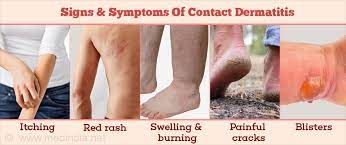Understanding Contact Dermatitis: Causes, Symptoms, and Treatment Options
Contact dermatitis is a type of skin irritation that occurs when the skin comes into contact with an allergen or irritant. This condition is characterized by red, itchy, and inflamed skin, and can be uncomfortable and even painful. In this article, we will explore the causes, symptoms, and treatment options for contact dermatitis, as well as what you can do to prevent this condition.
Causes of Contact Dermatitis
Contact dermatitis can be caused by a variety of allergens and irritants, including:
Chemicals: Certain chemicals, such as detergents, soaps, and fragrances, can cause contact dermatitis. These chemicals can irritate the skin and cause redness, itching, and inflammation.
Metals: Certain metals, such as nickel and cobalt, can cause contact dermatitis in some people. This can occur when the metal comes into contact with the skin, such as when wearing jewelry or using metal tools.
Plants: Certain plants, such as poison ivy and poison oak, can cause contact dermatitis when the skin comes into contact with their leaves or sap.
Rubber: Some people may experience contact dermatitis when their skin comes into contact with rubber, such as in gloves or rubber bands.
Symptoms of Contact Dermatitis
The symptoms of contact dermatitis can vary, depending on the cause and severity of the condition. Common symptoms include:
Redness: The skin may become red, inflamed, and irritated in the affected area.
Itching: The skin may itch, burn, or sting in the affected area.
Blisters: In severe cases, blisters may develop in the affected area.
Dryness: The skin may become dry, flaky, or scaly in the affected area.
Cracking: The skin may crack or peel in the affected area.
Treatment of Contact Dermatitis
The treatment of contact dermatitis depends on the cause and severity of the condition. Common treatments include:
Avoidance: Avoiding the allergen or irritant that is causing the dermatitis is the best way to prevent the condition from worsening.
Over-the-Counter Creams: Over-the-counter creams, such as hydrocortisone creams, can help relieve the symptoms of contact dermatitis. These creams can be applied directly to the affected area to reduce redness, itching, and inflammation.
Prescription Creams: If over-the-counter creams are not effective, a doctor may prescribe stronger creams or ointments to help relieve the symptoms of contact dermatitis.
Antihistamines: Antihistamines can help relieve itching and other symptoms of contact dermatitis.
Phototherapy: In severe cases, phototherapy may be recommended to help relieve the symptoms of contact dermatitis. This involves exposing the affected area to specific types of light, such as ultraviolet light, to help reduce redness, itching, and inflammation.
Preventing Contact Dermatitis
Preventing contact dermatitis is the best way to avoid this condition. Some steps you can take to prevent contact dermatitis include:
Avoiding Known Irritants: Avoiding known irritants and allergens is the best way to prevent contact dermatitis. If you know that a certain chemical or substance causes contact dermatitis, avoid it.
Wearing Protective Clothing: Wearing protective clothing, such as gloves, when handling chemicals or other irritants can help protect your skin and prevent contact dermatitis.
Testing New Products: Before using a new product, such as a new soap or cosmetic, test a small area of your skin to see if you have a reaction. If you experience any redness, itching, or inflammation, avoid using the product.
Washing Your Skin: Wash your skin immediately after coming into contact with an irritant or allergen. This can help remove the irritant and prevent contact dermatitis from developing.
Identifying Allergens: If you experience frequent outbreaks of contact dermatitis, consider getting an allergy test to identify any allergens that may be causing your symptoms.
Conclusion
Contact dermatitis is a common skin condition that occurs when the skin comes into contact with an allergen or irritant. Symptoms of contact dermatitis can include redness, itching, and inflammation, and can range from mild to severe.
The best way to treat contact dermatitis is to avoid the allergen or irritant that is causing the condition. Over-the-counter creams, prescription creams, and antihistamines can help relieve the symptoms of contact dermatitis, and phototherapy may be recommended in severe cases.
Preventing contact dermatitis is the best way to avoid this condition. By avoiding known irritants, wearing protective clothing, testing new products, washing your skin, and identifying allergens, you can help prevent contact dermatitis and maintain healthy, clear skin.











